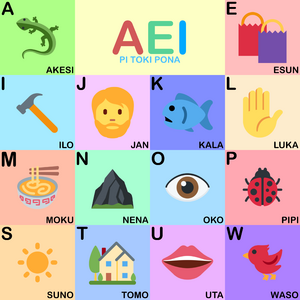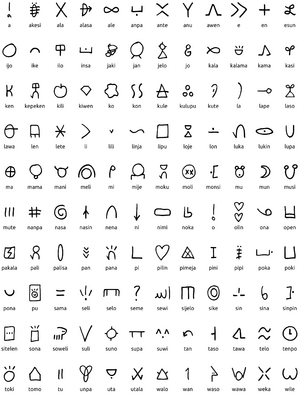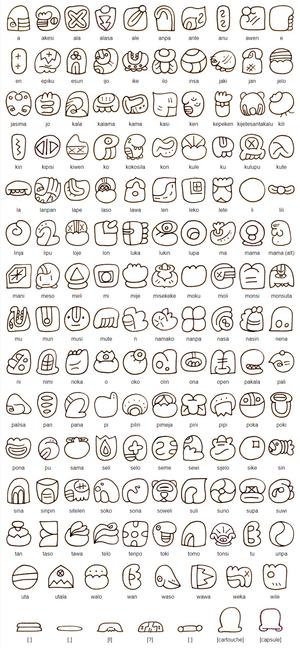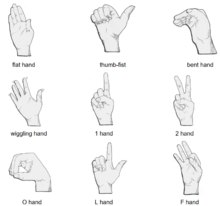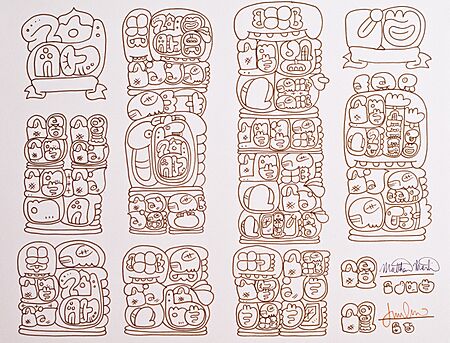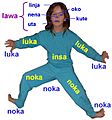Toki Pona facts for kids
Quick facts for kids Toki Pona |
||||
|---|---|---|---|---|
| toki pona | ||||
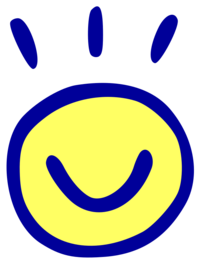
The Toki Pona logo, presenting the words toki pona written in sitelen pona
|
||||
| Created by | Sonja Lang | |||
| Date | 2001 | |||
| Setting and usage | Testing principles of minimalism, the Sapir–Whorf hypothesis and pidgins | |||
| Users | 500 ~ 5000 (2021) | |||
| Purpose |
Constructed language, combining elements of the subgenres personal language and philosophical language
|
|||
| Writing system | Latin script sitelen pona (logographic) sitelen sitelen (logographic with an alphasyllabary for foreign words); and numerous other community-made scripts |
|||
| Sources | A posteriori language, with elements of English, Tok Pisin, Finnish, Georgian, Dutch, Acadian French, Esperanto, Serbo-Croatian and Chinese | |||
|
||||
Toki Pona is a special made-up language known for being very simple. It has a small vocabulary and is easy to learn. The name toki pona means 'good language' or 'simple language'.
A Canadian linguist and translator named Sonja Lang created Toki Pona. She wanted to simplify her thoughts and how she communicated. The first ideas for the language came out online in 2001. The full version was published in her 2014 book, Toki Pona: The Language of Good. She also released a dictionary in 2021 called Toki Pona Dictionary.
Toki Pona is a very simple language with only 14 sounds. It uses basic, common ideas to help people express a lot with very few words. Sonja Lang's first book had about 120 words. Her later dictionary lists 137 "essential" words. The words are easy for people from different language backgrounds to say. This helps it act as a bridge for communication.
The language was partly inspired by Taoist philosophy. It aims to help users focus on basic things and think positively. Even with its small vocabulary, people can understand and talk to each other. They use the situation, combine words, and explain things to share more specific meanings.
After it was first created, a small group of people started using Toki Pona in the early 2000s. Most of their activities happen online in chat rooms and on social media. There have also been a few in-person meetings.
| Top - 0-9 A B C D E F G H I J K L M N O P Q R S T U V W X Y Z |
What Does "Toki Pona" Mean?
The name of the language has two parts. toki means 'language' or 'talk'. It comes from the word tok in Tok Pisin, which is similar to the English word talk.
pona means 'good' or 'simple'. It comes from the Esperanto word bona, which is like the Latin word bonus. So, toki pona means both 'good language' and 'simple language'. This shows that the language wants speakers to find joy in simple things.
Why Was Toki Pona Created?
One main goal of Toki Pona is to be very simple. It's designed to express big ideas with very little complexity. Like a pidgin (a simple language used for communication between groups), it focuses on basic ideas that are common in most cultures. It has a small vocabulary and only 14 sounds. This makes it easy for people from different language backgrounds to pronounce.
Another goal of Toki Pona is to help speakers focus on what's important. It breaks down complex ideas into simple parts. From these simple parts, more complex ideas can be built by combining words. This helps users see the basic meaning of what they are saying.
Toki Pona was also designed to encourage positive thinking. This idea comes from the Sapir–Whorf hypothesis. This theory suggests that a language can influence how its speakers think and act.
The language also aims to help speakers be more aware of the present moment. It encourages them to pay more attention to their surroundings and the words they use. According to its creator, it's meant to be "fun and cute."
Even though it wasn't made to be a language for everyone around the world, a global online community uses it to talk to each other.
The Story of Toki Pona
Sonja Lang, a Canadian linguist and translator, created Toki Pona. She was born in 1978 in Moncton, New Brunswick. Sonja grew up in a family where her mother spoke French and her father spoke English. She learned five languages, including Esperanto, which inspired her to create her own languages.
In 2001, Sonja was dealing with depression. She started working on Toki Pona as a way to simplify her thoughts. An early version of the language was put online that same year and quickly became popular. People discussed the language in a Yahoo! group, suggesting changes and sharing resources.
In 2014, Sonja Lang released her first book about the language, Toki Pona: The Language of Good. This book had 120 main words and showed a complete form of the language. In 2016, a French version of the book was also published.
In 2021, Lang released her second book, Toki Pona Dictionary. This book is a large dictionary that includes over 11,000 entries. It shows how the language is used by its community. It lists the original 120 words plus 16 new "major dictionary words" (nimi ku suli). It also includes 45 "minor dictionary words" (nimi ku pi suli ala).
In January 2022, Toki Pona was given an official ISO 639-3 code, which is "tok". This is a special code for languages.
Toki Pona has been used in some scientific studies. It has also been used for artificial intelligence and software tools. Some people even use it as a way to help with negative thinking. In 2010, it was chosen for a project called ROILA. This project studied how well machines could understand speech using a simple language. Toki Pona worked much better than English for this purpose.
In 2024, Lang released The Wonderful Wizard of Oz (Toki Pona edition). This is the first in a series of illustrated storybooks in Toki Pona. These books help people use the language, not just learn it.
Sounds and Pronunciation
Toki Pona has a very small set of sounds: nine consonants and five vowels. This makes it easy for most people to pronounce. When you say a word, the first part (syllable) is usually stressed, meaning it's said a bit louder or longer.
There are no complex sounds like diphthongs (two vowel sounds in one syllable) or consonant clusters (like 'str' in 'street'). The sounds and how they fit together are similar to many human languages, making it easy to learn.
Proper nouns (like names of people or places) are usually changed into Toki Pona "proper adjectives." This means they are simplified to fit the Toki Pona sound rules. For example, "England" or "English" becomes Inli, and "John" becomes San.
| -a | -an | -e | -en | -i | -in | -o | -on | -u | -un | |
|---|---|---|---|---|---|---|---|---|---|---|
| ∅- | a | an | e | en | i | in | o | on | u | un |
| p- | pa | pan | pe | pen | pi | pin | po | pon | pu | pun |
| t- | ta | tan | te | ten | to | ton | tu | tun | ||
| k- | ka | kan | ke | ken | ki | kin | ko | kon | ku | kun |
| m- | ma | man | me | men | mi | min | mo | mon | mu | mun |
| n- | na | nan | ne | nen | ni | nin | no | non | nu | nun |
| s- | sa | san | se | sen | si | sin | so | son | su | sun |
| l- | la | lan | le | len | li | lin | lo | lon | lu | lun |
| w- | wa | wan | we | wen | wi | win | ||||
| j- | ja | jan | je | jen | jo | jon | ju | jun |
Writing Systems
Toki Pona uses 14 letters from the Latin alphabet: a e i j k l m n o p s t u w. These letters sound like they do in the International Phonetic Alphabet. For example, j sounds like the y in "yes". The vowels sound like those in Spanish.
When writing Toki Pona, you use capital letters only for proper nouns (like names). Toki Pona words themselves are always written with small letters, even at the start of a sentence.
Besides the Latin alphabet, there are other ways to write Toki Pona. The most popular ones are two logographic systems: sitelen pona and sitelen sitelen. Both were included in Sonja Lang's book.
Sitelen Pona
sitelen pona means 'good/simple writing/drawing'. Sonja Lang created this writing system herself. It was first published in her 2014 book. In this system, each word has its own special symbol. It looks a bit like hieroglyphs with simple, childlike shapes.
If a word is an adjective (describing something), its symbol can be written inside or above the symbol of the word it describes. For example, the symbol for the language ![]() is written with the symbol
is written with the symbol ![]() (pona) inside the symbol
(pona) inside the symbol ![]() (toki).
(toki).
sitelen sitelen
The sitelen sitelen ('drawn writing') system is also called sitelen suwi ('cute writing'). Jonathan Gabel created it. This system is more detailed and uses two ways to form words:
- logograms (symbols for whole words)
- an alphasyllabary (symbols for syllables, especially for names)
The designs of these symbols are artistic. They are meant to help people slow down and think about how language and communication affect their thoughts. The look of sitelen sitelen is inspired by different art styles, including Egyptian hieroglyphs and Chinese characters.
Grammar
Toki Pona uses a simple word order: subject–verb–object.
- The word li comes before the verb.
- The word e comes before the direct object (the thing the verb acts on).
-
Subject + "li" + Verb + "e" + Object
A noun is followed by its modifiers (like adjectives). A verb is also followed by its modifiers. The position of a word in a sentence tells you what it means. This allows Toki Pona's few words to be used in many ways. For example, the word moku can mean:
- "to eat" when it's a verb.
- "food" when it's a noun.
- "edible" when it's an adjective.
Toki Pona has different types of sentences:
- Interjections: Single words like pona ('good!') or toki ('hello!').
- Statements: Follow the subject-predicate structure. If the subject is mi ('I') or sina ('you'), you don't use li.
- Commands/Wishes: Use o before a verb for a command. You can also use o to express wishes.
- Questions:
* For yes/no questions, you repeat the verb with ala in between (e.g., pona ala pona? - 'Is it good?'). * Another way is to add anu seme? ('or what?') at the end. * To ask "who," "what," or "where," you replace the unknown part with seme.
Pronouns
Toki Pona has four basic pronouns:
- mi (I, me, we, us)
- sina (you)
- ona (he, she, it, they)
- ni (this, that)
The pronouns don't tell you if it's one person or many, or if it's male or female. You can add other words to specify this if needed.
Nouns
Because Toki Pona has so few words, it often uses noun phrases. This is where a noun is followed by another word to make a more complex meaning. For example, jan means 'person'. If you add utala ('to fight'), you get jan utala, which means 'fighter' or 'soldier'.
Nouns don't change form for singular or plural. jan can mean 'person' or 'people' depending on the situation.
Proper nouns (like names of people or places) are always used with a common noun before them. For example, you say ma Kanata (literally 'land Canada') for 'Canada', or jan Lisa (literally 'person Lisa') for 'Lisa'.
Modifiers
In Toki Pona, words that describe something (modifiers) always come after the word they describe.
- soweli utala means 'fighting animal' (animal of fighting).
- utala soweli means 'animal war' (fighting of animal).
If you have more than one modifier, they all describe the first word. For example, jan pona mute means 'many good people'. Both pona ('good') and mute ('many') describe jan ('person').
If you want a group of modifiers to act as one unit, you use the word pi. For example, jan pi pona mute means 'a very good person'. Here, pona mute ('much goodness') acts as one idea describing jan.
Vocabulary
Toki Pona has about 120 to 137 words. Each word can have many meanings that are related. For example, suli means 'big', 'long', and 'important'. What a word means depends a lot on the situation.
To express more complex ideas, you combine words. For example, jan pona can mean 'friend', but it literally translates to 'good person'. To say 'to teach', you can use pana e sona, which means 'give knowledge'.
Colors

Toki Pona has five basic words for colors:
- pimeja (black)
- walo (white)
- loje (red)
- jelo (yellow)
- laso (blue and green)
Even though there are only five words, speakers can combine them to describe more specific colors. For example, "purple" can be laso loje ('a reddish shade of blue') or loje laso ('a bluish shade of red').
Numbers
Toki Pona has words for:
- wan (one)
- tu (two)
- mute (many)
Also, ala can mean 'zero' (literally 'none'), and ale ('all') can mean a very large or infinite amount.
The simplest way to count uses these five words. For numbers bigger than two, you just use mute for 'many'.
There's also a more complex system for larger numbers. You can add words together, like tu wan for three, or tu tu for four. This system makes it hard to talk about very large numbers, which is on purpose. In Lang's book, luka ('hand') means 'five', mute ('many') means 'twenty', and ale ('all') means 'hundred'. So, ale tu would mean '102'.
Where Toki Pona Words Come From
Most Toki Pona words come from languages like English, Tok Pisin, Finnish, Georgian, Dutch, Acadian French, Esperanto, and Serbo-Croatian. A few words come from Chinese.
Many words are easy to recognize. For example, toki ('speech, language') is like Tok Pisin tok and English talk. pona ('good, positive') is like Esperanto bona and French bon.
However, some words are harder to guess because their sounds changed to fit Toki Pona's simple sound rules. For example, lape ('to sleep, to rest') comes from Dutch slapen, which is related to English sleep.
About 12% of Toki Pona words come directly from English. But many words from Tok Pisin, Esperanto, and other languages are also similar to English words. This means about 30% of the vocabulary is easy for English speakers to recognize.
Signed Toki Pona
There are ways to sign Toki Pona with your hands.
- Signed Toki Pona (toki pona luka): This is a system where each Toki Pona word and letter has its own sign. You use hand shapes, hand locations, and palm directions to make the signs. You follow Toki Pona's grammar and word order.
- Luka Pona (luka pona): This is a more natural sign language. It's more popular in the Toki Pona community. It has its own grammar, but its words often match Toki Pona words. Its signs are more like what they mean. Many signs come from natural sign languages. In her book, Sonja Lang suggests learning luka pona instead of toki pona luka.
The Toki Pona Community
Toki Pona is quite well-known among people who speak Esperanto. They often offer classes and conversation groups at their meetings. In 2007, Sonja Lang said that at least 100 people spoke Toki Pona fluently. She thought a few hundred more had a basic understanding.
Most people use the language online on social media, in forums, and other groups. The largest groups are on Facebook, Discord, and Reddit. As of 2023, the biggest Facebook group has over 6,000 members, and the largest Reddit group has over 19,000 members. The biggest Discord group has over 10,000 members.
In November 2021, Toki Pona was added as a language option for the video game Minecraft. It's also available on the fanfiction website Archive of Our Own.
Learning Resources
You can find learning materials for Toki Pona on Memrise, which are created by users.
Literature
There are a few published books and many other writings in Toki Pona. Most published books are for learning the language, like akesi seli lili and meli olin moli. Many other works are translations of books from other languages. Since 2020, a group has been publishing a zine (a small, self-published magazine) in Toki Pona called lipu tenpo ('book of time').
Sample Texts
tenpo li lili
This is an original poem about time by jan Jasun. It won first place in a poetry contest in 2023.
ona li wawa li lawa li tawa
ali la ona li ken awen ala
ona li mute li suli li lon
li kama e moli
li weka e kon
tenpo
li lili
e musi e mi
e ken pali ali pi jan pali ni
tenpo li moku e tenpo mi sona
mi wile e tenpo tan wile mi pona
jan Sitata (excerpt)
These are the first lines of jan Sitata by jan Kala. It's a 2022 Toki Pona translation of the novel Siddhartha by Hermann Hesse.
jan Sitata li sama waso alasa li pona lukin li jan lili pi jan sona sewi · ona en jan sama Kowinta pi jan sona sewi ante li kama suli lon pimeja tomo, lon suno pi telo linja, lon poka pi tomo tawa telo, lon pimeja pi ma kasi Sawa, lon pimeja pi kasi kili · jan Sitata li lon telo la ona li pana sewi li telo e sijelo kepeken nasin sewi · suno li pimeja lili e selo walo ona · jan Sitata li lon ma kasi kili la kasi li pimeja e lukin ona · ona li musi li kute e kalama pi mama meli ona · ona li nasin sewi li kute e toki pi mama sona ona ·
Here's what it means in English:
Siddhartha was like a bird of prey, handsome, and the child of a religious scholar. He and his friend Govinda, who was from another religious scholar, grew up in the shade of the house, in the sun of the river, near the boats, in the shade of the Salwald forest, in the shade of the fruit tree. When Siddhartha was in the water, he gave sacred offerings and washed himself in the holy way. The sun tanned his pale skin. When Siddhartha was in the fruit tree grove, the trees shaded his eyes. He played, and heard the song of his mother. He followed the sacred ways, and listened to the teachings of his learned father.
Images for kids
See also
 In Spanish: Toki pona para niños
In Spanish: Toki pona para niños
- Philosophical language


